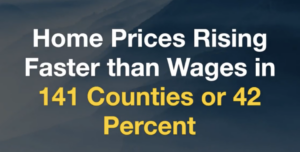 Renting vs. Buying: what can the average American worker afford?
Renting vs. Buying: what can the average American worker afford?
For anyone seeking a place to call home, whether renting or buying, it's important to take housing costs and outside finances into account. Which option is more suitable for the average U.S. worker's budget?
ATTOM's 2024 Rental Affordability Report showed that median three-bedroom rents in the U.S. are, in fact, more affordable than owning a similarly-sized home in nearly 90% of local markets around the nation.
The report revealed that both renting and owning a three-bedroom home continue to pose significant financial burdens for average workers, consuming more than one-third of their wages in most county-level housing markets. However, median rental rates still require a smaller portion of average wages than major home-ownership expenses on three-bedroom properties in 296—88%—of the 338 U.S. counties with enough data to analyze.
That gap extends to 2023 trends, although rents have grown faster than home prices over the past year in the U.S.
"Continuously increasing home prices contribute to the escalation of rental costs, making both buying and renting properties a challenging endeavor across most of the United States," said Rob Barber, CEO at ATTOM. "But the latest data shows that even as rents are growing faster, they remain more affordable than owning."
So, does the trend of favoring renting over homebuying reflect housing market trends that offer limited, simple options for home shoppers but ultimately lean towards the advantage of rentals?
The report showed that over the course of 2023, rental rates and home prices have risen in most of the U.S., as rental rates have climbed even faster in the majority of counties with enough data to analyze. That has happened as elevated home prices have become "further and further out of reach" for average workers, preventing those with minimal finances from obtaining mortgages—eaving them with few options other than renting.
Key Highlights from the 2024 Rental Affordability Report:
- Changes in rents are outpacing home price trends in nearly two-thirds of the U.S. Median rents for three-bedroom homes have increased more over the past year, or declined less, than median prices for single-family homes in 210, or 62%, of the 338 counties analyzed in this report. Changes in three-bedroom rents have commonly ranged from 3% decreases to 15% increases, while changes in median sale prices for single-family homes last year typically ranged from 3%losses to 7% gains.
- The most populous counties have the widest affordability gaps between renting and owning. Renting a three-bedroom home is still difficult for average workers, but will be most affordable in 2024 compared to owning a median-priced single-family home in the nation's largest counties. In almost three-quarters of markets with populations of at least 1 million, the portion of average local wages consumed by renting is at least 10 percentage points lower than the portion required for typical major home ownership expenses.
- Renting three-bedroom homes stretches out budgets but remains most affordable in the South and Midwest. The median three-bedroom rent requires more than one-third of the average local wage in 274 of the 338 counties analyzed for the report—an estimated 81%. Among the 64 markets where median three-bedroom rents require less than one-third of average local wages, roughly 59 are in the Midwest and South.
- Most-affordable home ownership markets are still in the South and Midwest; the least affordable are in the West and Northeast. The most affordable markets for owning are Wayne County (Detroit), MI (19% of average local wages needed to own); Montgomery County, AL (21%); St. Louis City/County, MO (23%); Bibb County (Macon), GA (23%; and Caddo Parish (Shreveport), LA (23%). The least affordable markets for owning among those analyzed are Marin County, CA (outside San Francisco) (164% of average local wages needed to own); Santa Cruz County, CA (160%); Orange County, CA (outside Los Angeles) (136%); Kings County (Brooklyn), NY (136%); and Honolulu County, HI (134%).
Home prices kept going up in 2023 despite rising mortgage rates, partly because of such a tight supply of homes for sale.
Despite renting and ownership consuming more than a third of average wages in most local markets, rents haven't escalated enough to keep them from being the more affordable option for average workers. That trend has held throughout the country but remains most pronounced in the most populous urban and suburban markets.
Top Five Most Affordable Southern and Midwest Counties for Owning a Home:
- Jefferson County (Birmingham), AL (22% of average local wages needed to rent)
- Wayne County (Detroit), MI (22%)
- Ingham County (Lansing), MI (22%)
- Genesee County (Flint), MI (23%)
- Caddo Parish (Shreveport), LA (23%)
Most Affordable Southern and Midwest Counties for Renting (among those with a population of at least 1 million and excluding Wayne County):
- Cuyahoga County (Cleveland), OH (24% of average local wages needed to rent)
- St. Louis County, MO (24%)
- Allegheny County (Pittsburgh), PA (26%)
- Philadelphia County, PA (28%)
Top Five Counties with the Widest Affordability Gaps:
- Honolulu (median three-bedroom rents consume 67 % of average local wages while typical single-home affordability consumes 134%)
- Kings County (Brooklyn), NY (72% for renting vs. 136% for owning)
- Alameda County (Oakland), CA (51% for renting vs. 108% for owning)
- Santa Clara County (San Jose), CA (29% for renting vs. 83% for owning)
- Orange County, CA (outside Los Angeles) (88% for renting vs. 136% for owning)
 Rents are growing faster than wages in the majority of markets.
Rents are growing faster than wages in the majority of markets.
Median three-bedroom rents are increasing more than average local wages in 197 of the 338 counties analyzed in the report (58%).
They include Los Angeles County, CA; Harris County (Houston), TX; Maricopa County (Phoenix), AZ; San Diego County, CA; and Orange County, CA (outside Los Angeles).
Average local wages are growing faster than average rents in 141 of the counties in the report (42%), including Cook County (Chicago), IL; Kings County (Brooklyn), NY; Miami-Dade County, FL; Queens County, NY; and San Bernardino County, CA.
Wages are growing faster than home prices in nearly 60% of the nation.
Average weekly wages are rising faster than median home prices in 197 of the 338 counties in the report (58%), reversing a pattern seen in 2023. They include Los Angeles County, CA; Cook County (Chicago), IL; Harris County (Houston), TX; Maricopa County (Phoenix), AZ; and San Diego County, CA.
Median home prices are rising faster than average weekly wages in 141 of the counties analyzed in the report (42%), including Orange County, CA (outside Los Angeles); Kings County (Brooklyn), NY; Miami-Dade County, FL; Broward County (Fort Lauderdale), FL; and Middlesex County, MA (outside Boston).
"Finding an affordable home remains a daunting prospect around the country for average workers, regardless of whether they want to buy or rent," said Barber.
Whether renting or buying, financial budgets are important. The task of finding a place to live remains a difficult challenge for most Americans, and hopefully that process will become easier throughout 2024.
To read the full report, including more data, charts, and methodology, click here.

 DSNews The homepage of the servicing industry
DSNews The homepage of the servicing industry









